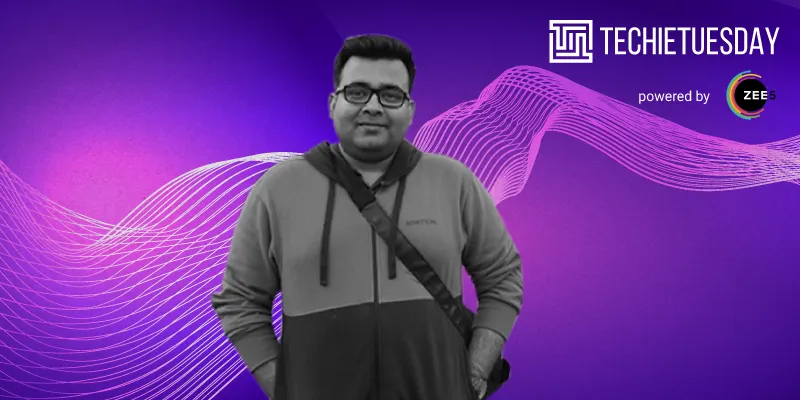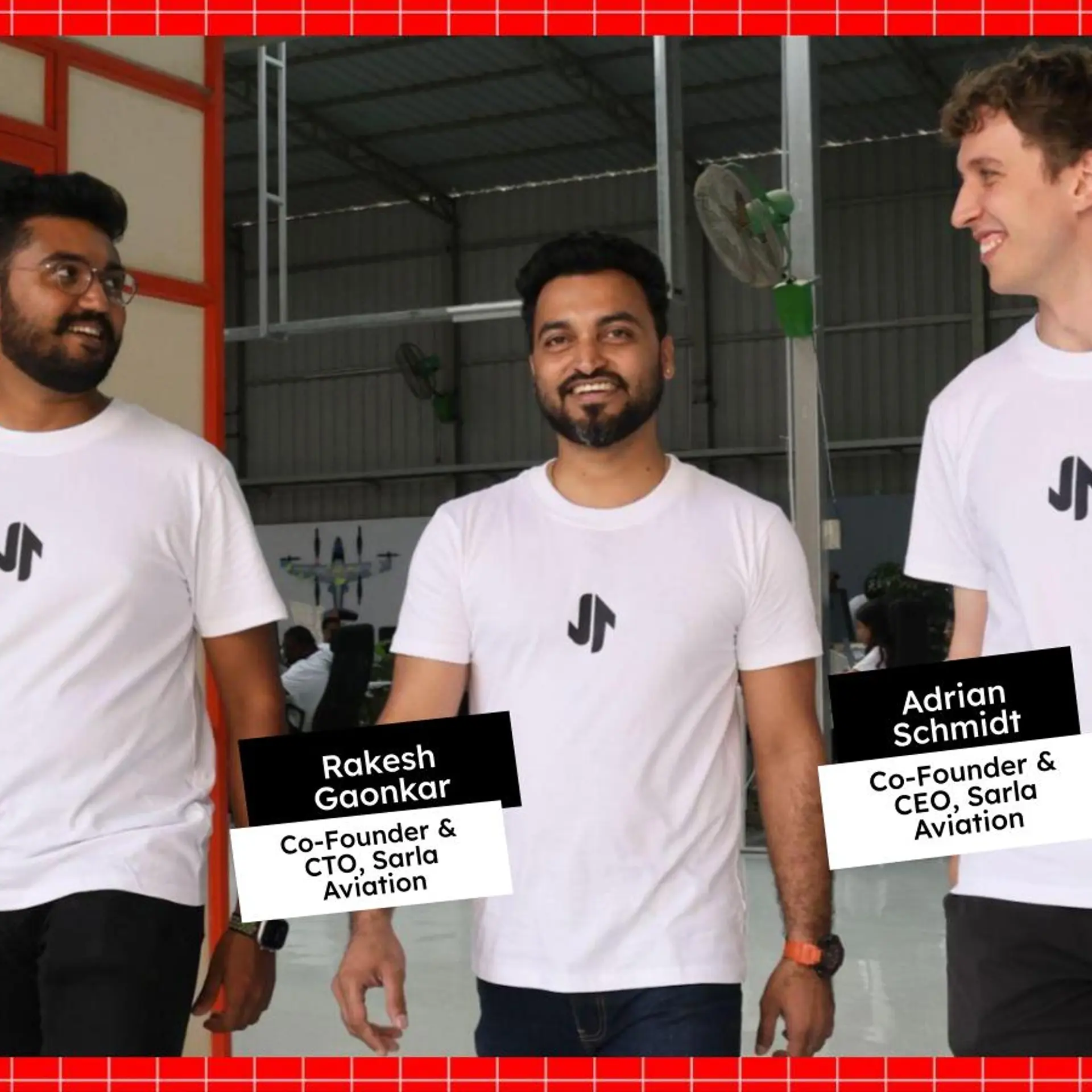[Techie Tuesday] Meet Sudipta Banerjee, the techie from a Bengal village who went on to build Wynk Music
Our techie for this Tuesday is Sudipta Banerjee, the CTO of Wynk Music and Airtel Xstream. He shares how his tech journey started at NIT Warangal, continued at HCL, Verizon India, and Yahoo where he acquired crucial learnings and tools, and took him to Airtel where he built Wynk Music.
Many people in small towns have big dreams. And very often serendipity nudges them ahead to fulfil them. This is what happened to Sudipta Banerjee, who comes from a small village in West Bengal and is now the CTO of Wynk Music and Airtel Xstream (Airtel TV).

Continuous learning is a must for engineers keen to build a competitive career in the software industry. On a fundamental level, it starts with learning a lot of programming languages. After that come software development kits (SDKs), which constitute the larger business framework of the company. The main differentiator between an experienced software developer and a seasoned tech architect is how well s/he is able to understand SDKs. This essentially involves abstracting all the complexities that exist in the path and readying a technical roadmap to communicate with the customer.
Sudipta Banerjee, the CTO of Wynk Music, the popular music streaming app, figured this out very early, when he was graduating from NIT Warangal.
He was working on a genetic algorithms project at IIT-Kharagpur, and a speaker-independent speech recognition model at IIIT Hyderabad in his third year of college when he began understanding the role of an SDK in shaping a technology-enabled product.
He tells YourStory, “Those were the days when ‘building from scratch’ did not have glamour attached to it. There was no such thing like a stack overflow. We depended heavily on manual pages. I learnt that it was okay to build numerous things on top of the existing SDK and still bring in a lot of optimisation and efficiency, rather than reinventing a wheel.”
The CTO believes that the inspiration of the product should be derived from the problem statement and solution, not the glamour around having to build something from scratch.
Learning to see the larger picture
Sudipta, 37, comes from a small village near West Midnapore (Paschim Medinipur) in West Bengal. He belongs to a family of teachers; his grandfather started an educational institute in the village and was a widely respected man.
His grandfather, Sudipta says, was that inspirational person who moulded his early thoughts and life. Life was easy, with “no rush to figure out career paths”. He was taught to be very good at anything he chose, and he recalls that his father always pushed him to score a 100 in mathematics because the subject had an objective approach, and there was no reason why he could not get a perfect score.

Because of this, Sudipta learnt to be very good at anything he chose, and learnt that he had to master it. Applied mathematics interested him, and he soon identified that software and programming was where the world was heading. Interestingly, it had the same premise as applied mathematics and Sudipta decided to join NIT Warangal to pursue computer science engineering between 2000 and 2004.
“Software is only a tool or an enabler. Artificial intelligence is only a tool or an enabler. The larger picture is something else: solving consumer problems is more important,” he says.
The bias between products and services
As Sudipta moved on from his projects on genetics and speech recognition, his time at college was nearly ending.
In the early 2000s, unlike now, there was “no such thing as a product company or a services-based company”, let alone choices for or against them. At the time, he grew increasingly inclined towards Java, and the challenging mechanism it offered developers while solving problems.

Sudipta with his daughter.
Sudipta joined HCL after he graduated with a simple expectation setting that he had to write code. He worked on an RSA security application, which was acquired by EMC in 2006. EMC was later acquired by Dell Technologies, and RSA security is now owned by the corporation.
With RSA, he was seeing the mechanisms of almost 14 operating systems and around 20 server architectures, while working on cryptography and two-factor authentication tokens. The idea was to create security plugins for web servers with these tools.
“My job was to crack the security framework for every server, across multiple operating systems. It was a beautiful experience to work alongside these different architectures during my first job itself,” he says.
After HCL, Sudipta moved to Verizon India as a senior software engineer and worked there for a little more than two years (between 2004 and 2006). The company was trying to set up a product development shop in Chennai, and – driven by the urge to solve consumer problems - he decided to grab the opportunity.
Verizon was developing a Voice over IP (VoIP) product, similar to today’s Skype. The product did not eventually take off, but the stint gave him a playground where he could play a long game with product development.
“I was running agile sprints with a six-member team and it was all about seeing your own product evolve. Almost all of us from that team are CTOs now,” he says.
Multiple learnings at Yahoo
Sudipta soon faced the most common conundrum engineers have: to get an MS degree in the US to join the software industry there, or to stay back and dig deeper. Today, he is glad that he decided to ditch the herd mentality and opt for the latter – for that journey is what led him to today’s destination.
Many of his college seniors were then working with Yahoo in Bengaluru. Sudipta was looking to expand his horizon, and uses just a few words to describe his stint with Yahoo from 2006 to 2010: “Wow! What a place!” He believes that much of his learning was amplified while he was with Yahoo.
“Though their business did not really take off with Google intervening, in terms of the quality of raw talent and their view towards building scalable products, Yahoo really did know what it was doing. Every team jotted down their own documentation, their everyday meeting notes, their challenges, and their general objectives, for the entire company to see. It was a great thing to have,” he says.
At Yahoo, he worked on Yahoo Finance and had to deploy solutions for all states in India, and several other demographies across the globe. His time at this project taught him to build for localisation and globalisation, and how to build architectures to ensure efficient localisation.
Startup vs multinational corporate
After four years at Yahoo, Sudipta felt kind of stymied – he had moved past his learning curve and wanted to explore the just-starting startup scene in Bengaluru. In 2010, he decided to join Bengaluru-based personal finance startup MoneySights, which went on to be acquired by the Times Internet group in 2014.
After a little over a year, Sudipta moved to XKLAIM as its head of engineering for two-and-a-half years before finally moving to Wynk, where he is now the CTO.

Sudipta recommends that engineers join a large tech company initially only to understand the scale at which these businesses run, and how product development goes in tandem with managing that scale.
By scale, he refers to the sheer size of the business, but not merely the number of users, visits, or transactions. When a company, at every stage, is well structured, well documented, and keeps track of how conversations flow within teams, it has the scope to redefine itself better in the future, he feels.
Sudipta believes that it is very important for engineers to build a level of capacity to understand these structural patterns, even outside of their technical expertise.
“Even at a startup, considering if it is in its Series C stage, young engineers should ideally try to understand the framework of how their code and product contribution actually solves the end user’s problems. People with a decent pedigree in software should always look at stable organisation as a testing ground,” he says.
Onward to Wynk Music
After working with the engineering departments of two startups, Sudipta took a sabbatical. He realised that he was missing the scale he operated at while he was with Yahoo.
A push from a friend, the HR head at Wynk Music (a subsidiary of Bharti Airtel), led to a call with the app’s business head who sits out of London. And Sudipta was on board. Soon after joining, he started off by A/B testing with numerous user reviews and requirements, but went on to build the application with “unglamorous tools”. He says Wynk’s competitors never invested deeply in analytics and user data while starting to build their applications.
The level of sophistication the Wynk app comes with, with respect to offline downloads and subsequent playlist development, is usually only seen in a native mobile OEM. Five years ago when the app development ecosystem was nascent; it came with its own set of fragmentation, undocumented stacks, and undocumented API systems.
“From having to download mp3 files from web portals to offering an online streaming service, the primary catalyst was internet connectivity for smartphones. The connectivity often fluctuates from 3G to 2G, and from 4G to 3G. Solving for these competencies, apart from also solving from mobile OEMs, was a challenge,” he says.
Indian internet users were using a music streaming app for the first time, and Sudipta’s team was also building a product like this for the first time, at scale. The team had a lot of data and user manifestos, which it leveraged to build the product’s roadmap.
He attributes that his major learning out of building Wynk is how one can build a powerful app business out of a solid data analytics system.
Recalling that fateful international call with Wynk’s business head, Sudipta says,
“I had to pay extra for that ISD call but I think it was worth it.”
(Edited by Teja Lele Desai)


![[Techie Tuesday] Meet Sudipta Banerjee, the techie from a Bengal village who went on to build Wynk Music](https://images.yourstory.com/cs/2/730b50702d6c11e9aa979329348d4c3e/4BBEB2C7-5758-4103-A7AF-A17506E55127-1579518051186.png?mode=crop&crop=faces&ar=2%3A1&format=auto&w=1920&q=75)
![[Techie Tuesday] How a farmer’s inability to get the best crop rate propelled Ananth Nagaraj to build speech recognition platform Gnani.ai](https://images.yourstory.com/cs/2/79900dd0d91311e8a16045a90309d734/techietuesday13-01-20201-1578899978996.png?fm=png&auto=format&h=100&w=100&crop=entropy&fit=crop)
![[Techie Tuesday] Here are the top 10 tech leaders we celebrated this year](https://images.yourstory.com/cs/2/730b50702d6c11e9aa979329348d4c3e/techietuesday--1577098660626.png?fm=png&auto=format&h=100&w=100&crop=entropy&fit=crop)
![[Techie Tuesday] PhonePe CTO Rahul Chari opted out of IIT to follow his heart and build a world-class product](https://images.yourstory.com/cs/2/3fb20ae02dc911e9af58c17e6cc3d915/RahulCharitechietuesday800x4001576480080084png?fm=png&auto=format&h=100&w=100&crop=entropy&fit=crop)
![[Techie Tuesday] He wanted to be a mechanical engineer, but blogged his way and built CRM company HubSpot](https://images.yourstory.com/cs/2/730b50702d6c11e9aa979329348d4c3e/techietuesday800x4001574674063366png?fm=png&auto=format&h=100&w=100&crop=entropy&fit=crop)





